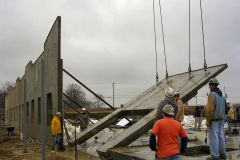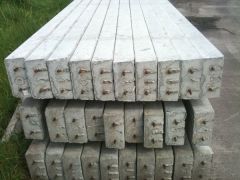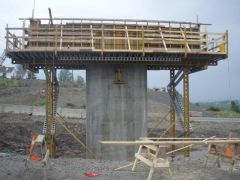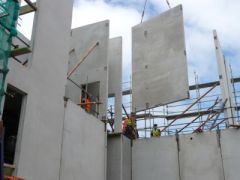![]()
![]()
![]()
Use LEFT and RIGHT arrow keys to navigate between flashcards;
Use UP and DOWN arrow keys to flip the card;
H to show hint;
A reads text to speech;
19 Cards in this Set
- Front
- Back
|
demand critical welds |
Demand-critical welds generally represent a small percentage of the welds made on any structure, but most fabricators and erectors are likely to specify one filler metal for the entire job. They usually use a filler metal that meets the requirements for demand-critical welds rather than take the chance that the wrong filler metal might be used in a demand-critical application. |
|
|
Terrazo |
Terrazzo has been described as a decorative form of concrete. Random sized marble chips are mixed in a binder, troweled, ground and polished. Good terrazzo has a smooth surface that is a mixture of 70% or more coarse marble aggregate and 30% or less Portland cement matrix. Terrazzo combines the durability of marble with the strength and economy of concrete. |
|
|
Labeled door |
A door that carries a certified fire-rating issued by Underwriters' Laboratories, Inc. |
|
|
vermiculite insulation |
is a hydrated laminar magnesium aluminum iron silicate. When heated it forms small worm like pieces. May contain asbestos. |
|
|
red cedar |
The tannic acid in red cedar has a corrosive effect on copper and galvanized fasteners. (Similarly, the tannic acid in red oak can have a corrosive effect on iron fasteners.) A galvanic reaction is caused by a metal to metal interaction and deals only with this. What is happening here is similar to acid washing copper to induce a patina quickly except that the copper is constantly being exposed to the acid being leached out of the shingles due to water. Lead -coated copper could be used with red cedar shingles and stainless steel fasteners for attaching any red cedar or redwood trim |
|
|
patina |
a thin layer that variously forms on the surface of stone; on copper, bronze and similar metals |
|
|
Nobility of Common Metals Table |
1. Aluminum 2. Zinc 3. Steel 4. Iron 5. Stainless Steel - Active 6. Tin 7. Lead 8. Copper 9. Stainless Steel - Passive
AZSITLCS All Zebras Sell Insulin Shots To Leave Chaotic Situations
|
|
|
baffle |
Best for uneven intersecting roof slopes and sizes. are recommended for traditional vented attics, (i.e., a pitched roof and the ceiling assembly acting as the thermal and air barrier). For effective attic ventilation, air needs to flow freely from the soffit vents and exit at the ridge vents. While these baffles allow loose-fill insulation blown into the attic to fully cover the top plates of the outside walls (thus providing a complete thermal barrier between the attic and the living spaces below), they also prevent the insulation material from falling into the soffits and blocking the vents. |
|
|
erosion corrosion |
This occurs when rain falls on a non-copper roof such as tile, slate, wood, or asphalt. The acidic water is not neutralized as it flows over the inert material. When water, collected over a large surface, is diverted or collected by a relatively small copper flashing or gutter, the copper may deteriorate before it develops a protective patina.
Another type of corrosion occurs at the drip edge of inert roofing material conducting water into a copper gutter or valley. If shingles rest directly on the copper, the corrosive effect is amplified because moisture is held along the edge by capillary action resulting in "line-corrosion". The solution is to raise the lower edge of the shingles with a cant strip, or to provide a replaceable reinforcing strip between the shingles and the copper. |
|
|
substrate |
the surface over which an material is laid |
|
|
attaching copper |
All applications that rely on nails or screws to attach the copper or cleats to the underlying structure require a nailable deck, nailing strips within the deck, or wood blocking at specific locations. Such applications include standing seam roofs, batten seam roofs, flat seam roofs, continuous edge strips and cleats, and flashings around roof penetrations. |
|
|
what is the best substrate for copper? |
wood
beware of fire-retardant and pressure treated wood. It often has reactive chemicals in it. |
|
|
Four Principles of CPTED |
Natural Surveillance Natural Access Control Territorial Reinforcement Maintenance and Management |
|
|
When to use aluminum with other metals? |
everything destroys aluminum |
|
|
bWhat are some considerations when choosing between wood, steel, or a combination? |
Steel: Lower depth, led deflection Wood: Inexpensive Combination: Stiffer/Lighter |
|

|
tilt up concrete construction - Tilt-Up, which combine reasonable cost with low maintenance, durability, speed of construction, and minimal capital investment. |
|

|
1. Prestressed concrete is a method for overcoming concrete's natural weakness in tension. It can be used to produce beams, floors or bridges with a longer span than is practical with ordinary reinforced concrete. |
|

|
Cast-in-place (CIP) concrete walls are made with ready-mix concrete placed into removable forms erected on site. Historically, this has been one of the most common forms of building basement walls. The same techniques used below grade can be repeated with above-grade walls to form the first floor and upper levels of homes. |
|

|
Precast concrete is a construction product produced by casting concrete in a reusable mold or "form" which is then cured in a controlled environment, transported to the construction site and lifted into place. In contrast,standard concrete is poured into site-specific forms and cured on site. |

